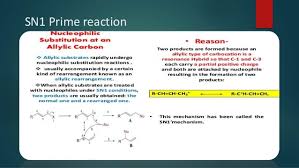
Nucleophilic Substitution Prime Reactions
Prime reactions
It is a nucleophilic substitution reactions in which allylic type substrate undergo substitution along with the rearrangement of double bond. Such nucleophilic substitution reactions are called prime reactions and rearrangements are known as allylic shifts.
SN1 Prime reaction
Rearranged product formed under SN1 condtion is SN1 prime product and reaction is called SN1 Prime reaction. It is a type of nucleophilic reaction in which molecularity of rate determing step is one. The rate of the reaction is proportional to the concentration of the substrate . It is a first order reaction.
For example CH3CH=CHCH2Cl on solvolysis with 0.8 M NaOH at 25 C yields 60% of CH3CH=CHCH2OH (Normal product) and 40% of CH3CHOHCH=CH2 (rearranged product).
In above example the nucleophile OH─ attacks gamma carbon instead of alpha carbon, as attacking nucleophile experiences steric repulsions from π - e- cloud. OH─ undergo nucleophilic addition at at gamma carbon, followed by π- bond rearrangement to next C- C bond & loss of leaving group Br─ forming product.
SN1 and SN1 prime both are uni-molecular reaction and proceed through a carbonation intermediate. But the difference is, when the reaction occurs on an allylic system the carbonation formed is not localized, rather delocalized.
Another example is the reaction of 3-bromobuta-1-ene, in which the bromine leaves instantly, double bond changes to the 2 position, and after that water attacks the 1 carbon which creates but-2-ene-1-ol.
CH2=CH-CH(Br)-CH3 CH2=CH-CH+-CH3 +CH2CH=CH-CH3
SN2 Prime reaction
SN2′ prime reaction takes place when allyl halide shown reacts with a OH- or any nucleophile. Here in reaction mechanism, the nucleophile OH- attacks gamma carbon instead of alpha carbon, as attacking nucleophile experiences Steric repulsions from π - e- cloud. Many reactions proceed through a series of steps.


